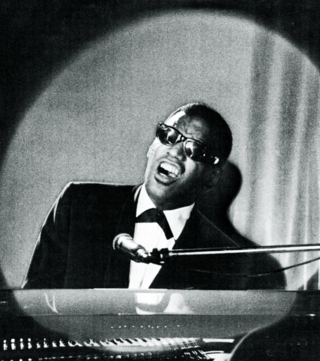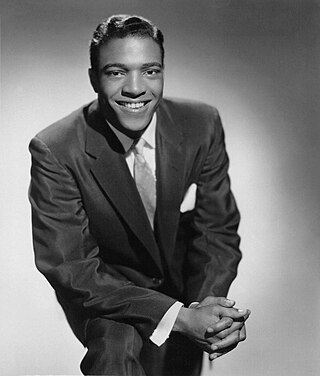Rock and roll is a genre of popular music that evolved in the United States during the late 1940s and early 1950s. It originated from African American music such as jazz, rhythm and blues, boogie-woogie, electric blues, gospel, and jump blues, as well as country music. While rock and roll's formative elements can be heard in blues records from the 1920s and in country records of the 1930s, the genre did not acquire its name until 1954.

Rhythm and blues, frequently abbreviated as R&B or R'n'B, is a genre of popular music that originated within the African-American community in the 1940s. The term was originally used by record companies to describe recordings marketed predominantly to African Americans, at a time when "rocking, jazz based music ... [with a] heavy, insistent beat" was starting to become more popular. In the commercial rhythm and blues music typical of the 1950s through the 1970s, the bands usually consisted of a piano, one or two guitars, bass, drums, one or more saxophones, and sometimes background vocalists. R&B lyrical themes often encapsulate the African-American history and experience of pain and the quest for freedom and joy, as well as triumphs and failures in terms of societal racism, oppression, relationships, economics, and aspirations.

Soul music is a popular music genre that originated in African-American communities throughout the United States in the late 1950s and early 1960s. It has its roots in African-American gospel music and rhythm and blues. Soul music became popular for dancing and listening, and U.S. record labels such as Motown, Atlantic and Stax were influential in its proliferation during the civil rights movement. Soul also became popular worldwide, directly influencing rock music and the music of Africa. It had a resurgence in the mid-to late 1990s with the subgenre neo soul, which incorporated modern production elements and hip hop influences.

Ruth Alston Brown was an American singer-songwriter and actress, sometimes referred to as the "Queen of R&B". She was noted for bringing a pop music style to R&B music in a series of hit songs for Atlantic Records in the 1950s, such as "So Long", "Teardrops from My Eyes" and "(Mama) He Treats Your Daughter Mean". For these contributions, Atlantic became known as "the house that Ruth built". Brown was a 1993 inductee into the Rock and Roll Hall of Fame.

Clyde Lensley McPhatter was an American rhythm and blues, soul, and rock and roll singer. He was one of the most widely imitated R&B singers of the 1950s and early 1960s and was a key figure in the shaping of doo-wop and R&B.

Jamesetta Hawkins, known professionally as Etta James, was an American singer and songwriter. Starting her career in 1954, James frequently performed in Nashville's famed R&B clubs, collectively known as the Chitlin' Circuit, in the 1940s, 1950s, and 1960s. She sang in various genres, including gospel, blues, jazz, R&B, rock and roll, and soul, and gained fame with hits such as "The Wallflower" (1955), "At Last" (1960), "Something's Got a Hold on Me" (1962), "Tell Mama", and "I'd Rather Go Blind". She faced a number of personal problems, including heroin addiction, severe physical abuse, and incarceration, before making a musical comeback in the late 1980s with the album Seven Year Itch (1988).

Delores LaVern Baker was an American rhythm and blues singer who had several hit records on the pop charts in the 1950s and early 1960s. Her most successful records were "Tweedle Dee" (1955), "Jim Dandy" (1956), and "I Cried a Tear" (1958).

Wilson Pickett was an American singer and songwriter.

Dinah Washington was an American singer and pianist, one of the most popular black female recording artists of the 1950s. Primarily a jazz vocalist, she performed and recorded in a wide variety of styles including blues, R&B, and traditional pop music, and gave herself the title of "Queen of the Blues". She was also known as "Queen of the Jukeboxes". She was a 1986 inductee of the Alabama Jazz Hall of Fame, and was inducted into the Rock and Roll Hall of Fame in 1993.

Tony Russell "Charles" Brown was an American singer and pianist whose soft-toned, slow-paced nightclub style influenced West Coast blues in the 1940s and 1950s. Between 1949 and 1952, Brown had seven Top 10 hits in the U.S. Billboard R&B chart. His best-selling recordings included "Driftin' Blues" and "Merry Christmas Baby".

Harold "Chuck" Willis was an American blues, rhythm and blues, and rock and roll singer and songwriter. His biggest hits, "C. C. Rider" (1957) and "What Am I Living For" (1958), both reached No.1 on the Billboard R&B chart. He was known as The King of the Stroll for his performance of the 1950s dance the stroll.

Lucius Venable "Lucky" Millinder was an American swing and rhythm-and-blues bandleader. Although he could not read or write music, did not play an instrument and rarely sang, his showmanship and musical taste made his bands successful. His group was said to have been the greatest big band to play rhythm and blues, and gave work to a number of musicians who later became influential at the dawn of the rock and roll era. He was inducted into the Alabama Jazz Hall of Fame in 1986.

Joseph Amos Milburn was an American R&B singer and pianist, popular in the 1940s and 1950s. One commentator noted, "Milburn excelled at good-natured, upbeat romps about booze and partying, imbued with a vibrant sense of humour and double entendre, as well as vivid, down-home imagery in his lyrics."
The origins of rock and roll are complex. Rock and roll emerged as a defined musical style in the United States in the early to mid-1950s. It derived most directly from the rhythm and blues music of the 1940s, which itself developed from earlier blues, the beat-heavy jump blues, boogie woogie, up-tempo jazz, and swing music. It was also influenced by gospel, country and western, and traditional folk music. Rock and roll in turn provided the main basis for the music that, since the mid-1960s, has been generally known simply as rock music.

Eddie Jones, known as Guitar Slim, was an American guitarist in the 1940s and 1950s, best known for the million-selling song "The Things That I Used to Do", for Specialty Records. It is listed in the Rock and Roll Hall of Fame's 500 Songs That Shaped Rock and Roll. Slim had a major impact on rock and roll and experimented with distorted tones on the electric guitar a full decade before Jimi Hendrix.

"Maybellene" is a rock and roll song by American artist Chuck Berry, adapted in part from the western swing fiddle tune "Ida Red". Released in 1955, Berry’s song tells the story of a hot rod race and a broken romance, the lyrics describing a man driving a V8 Ford and chasing his unfaithful girlfriend in her Cadillac Coupe DeVille. It was released in July 1955 as a single by Chess Records, of Chicago, Illinois. Berry's first hit, "Maybellene" is considered a pioneering rock and roll song. Rolling Stone magazine wrote of it, "Rock & roll guitar starts here." The record was an early instance of the complete rock and roll package: youthful subject matter; a small, guitar-driven combo; clear diction; and an atmosphere of unrelenting excitement.

"Sixty Minute Man" is an R&B record released on Federal Records in 1951 by the Dominoes. It was written by Billy Ward and Rose Marks and was one of the first R&B hit records to cross over to become a hit on the pop chart. It is regarded as one of the most important of the recordings that helped generate and shape rock and roll.
Rudolph Toombs was an American performer and songwriter. He wrote "Teardrops from My Eyes", Ruth Brown's first number one R&B song, and other hit songs for her, including "5-10-15 Hours". He also wrote "One Mint Julep" for The Clovers.

"The Things That I Used to Do" is a blues standard written by Guitar Slim. He recorded it at Cosimo Matassa's J&M Recording Studio in New Orleans, where the young Ray Charles arranged and produced the session. Specialty Records released the song as a single in 1953 and it became a bestseller the following year. Specialty founder Art Rupe believed that the appeal would be limited to the Southern U.S. rural audience. However, urban rhythm and blues radio stations in the North began airing the song and built it into a national hit. As a result, Guitar Slim became in great demand as a performer and played at venues such as the Apollo Theater in New York City.

"Driftin' Blues" or "Drifting Blues" is a blues standard, recorded by Johnny Moore's Three Blazers in 1945. The song is a slow blues and features Charles Brown's smooth, soulful vocals and piano. It was one of the biggest blues hits of the 1940s and "helped define the burgeoning postwar West Coast blues style". "Driftin' Blues" has been interpreted and recorded by numerous artists in various styles. The Blues Foundation Hall of Fame and the Rock and Roll Hall of Fame have acknowledged the influence and lasting popularity of the song.
















